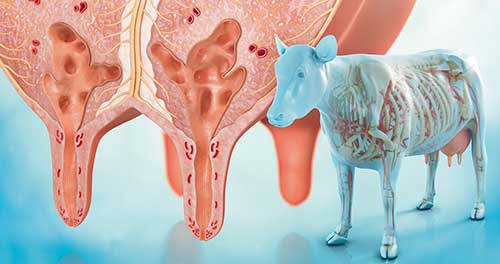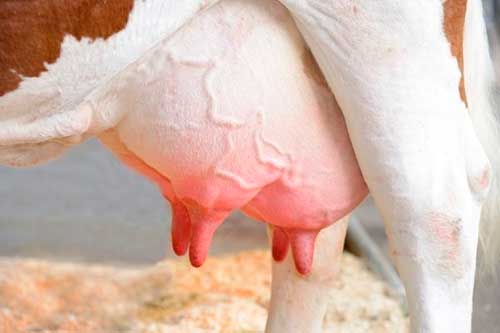See also
- Artificial insemination
- Breed of bees
- Breed's of cows
- Breeds of pigs
- Calving cows. How to prepare for calving. Receiving calf
- Dairy breeds of cows and bulls. The productivity of dairy cattle
- Duroc
- Estimation of bulls on quality of posterity
- Hereford cattle
- Holstein breed
- Landrace - bacon pigs
- Limousin cattle breed
- Marble beef
- Mastitis in cows
- Meat breed of sheep, their characteristics and photo
- Meat breeds of cows and bulls. The productivity of beef cattle
- Simmental breed of cattle
- The Aberdeen-Angus cows. Description and characteristics of the breed
- The farrowing of pigs: preparing for farrowing, farrowing, care of a pig and piglets after farrowing
- The Yorkshire breed of pigs
- Vietnamese pigs. Description of the breed, breeding, maintenance and care
- What is the difference netel from heifers or cows?
- What is the meat yield in pigs — a mechanism to define and calculate deadweight
- Zootechnical rules
It's interesting
Mastitis in cows
Mastitis is a disease expressed in inflammation of the mammary gland (udder), manifested under the influence of biological, mechanical, thermal and chemical factors. With mastitis, microbes, viruses, fungi and mycoplasmas are detected in the udder. In the case of exposure to the udder of mechanical (injury), thermal (hypothermia) and chemical (toxins) factors, mastitis can occur aseptically, i.e. without the participation of any biological pathogens. It must be borne in mind that the inflammatory process in the mammary gland is a manifestation not only of the reaction of the udder, but also of the whole organism.

It’s important to diagnose the disease on time
It has been precisely established that the course, successful treatment and outcome of mastitis depend on the state of the whole organism, the reactivity of the tissues of the udder, the localization of the process and the pathogenic properties of the pathogens.
The development of mastitis is accompanied by impaired metabolism and trophic tissue of the mammary gland, impaired innervation, loss of enzymatic activity, decreased production of the hormones oxytocin and vasopressin, the development of inflammatory hyperemia, stagnant processes, plasma exudation and the emigration of blood cells from the walls of blood vessels into the surrounding tissues, which in turn, leads to a violation of trophic tissue and innervation of the mammary gland.
The disease causes substantial material damage in large-scale milk production enterprises. The economic damage from mastitis consists of a decrease in volumes, a deterioration in the grade of marketed milk, the costs of diagnosis and treatment, and losses from the disposal of animals from the productive herd due to illness.

Mastitis is a dangerous disease
With inflammation of the udder, as part of the body's defensive reaction, natural inhibitory substances appear in milk, which can cause a positive reaction in standard diffusion tests used by milk processing plants to determine residual amounts of antibiotics and sulfamide substances in milk.
To avoid erroneous rejection of products, it is necessary to exclude the ingress of milk from sick cows into the general milk line. In practice, milk from sick cows from sick quarters of the udder is milked into separate containers.
Types of mastitis
Mastitis can occur during periods of lactation, start-up and deadwood. There are serous, catarrhal, purulent, hemorrhagic, fibrinous types of inflammation of the mammary gland. Also, specific inflammatory processes that are the result of foot and mouth disease, tuberculosis and other infectious diseases can be localized in the mammary gland. These processes cannot be regarded as ordinary and often encountered in veterinary practice inflammation of the udder. The nature of changes in the tissues of the mammary gland with foot and mouth disease, actinomycosis and tuberculosis are not considered within the framework of the classical forms of inflammation of the udder. The treatment regimen for such mastitis is inextricably linked with the implementation of specific measures aimed at combating these diseases and is not considered in the framework of this article.
Success factors in the treatment of mastitis
- Early diagnosis.
- Immediate treatment immediately after diagnosis.
- The use of anti-inflammatory drugs.
- The use of broad-spectrum antimicrobials, including well-fed antibiotics. (Subtitle - a study of the sensitivity of microorganisms that caused the disease to antibiotics).
With inflammation, the udder of the cows becomes hard to the touch, swells, the temperature rises, painful, with severe disease, tissue necrosis is observed. It should be noted that these signs are mainly manifested in the late stages of the disease. For early diagnosis of mastitis in cows, the Somatic-Expert solution for diagnosis is widely and successfully used. The high sensitivity and reliability of the test is due to the visual observation of two factors at once: viscosity and color intensity of the sample, similar to the gold standard of international veterinary practice - the California test.
Early detection of subclinical mastitis in cattle allows you to quickly apply treatment and prevent the onset of significant economic damage to the enterprise.

Early diagnosis is the key to a quick cure
There are several different treatments for mastitis.
- 1. The treatment regimen for mastitis in cows with drugs that allow the use of milk for food without restriction
- 2. The treatment regimen for mastitis in cows with drugs that are allowed to use milk for food purposes with a restriction of 60 hours after the last use
- 3. The treatment regimen for cows with mastitis, drugs that are allowed to use milk for food purposes with a restriction of 72 hours after the last use (in severe cases of the disease)
The treatment regimens for mastitis presented here are an example for constructing individual regimens that are applicable in a particular case at the place of occurrence of the problem. A successful treatment regimen for mastitis is provided by directed influence on the cause of the disease, on factors that ensure a break in the vicious circle of support for inflammation, leading to the normalization of metabolic processes not only of the organ, but of the whole organism.

